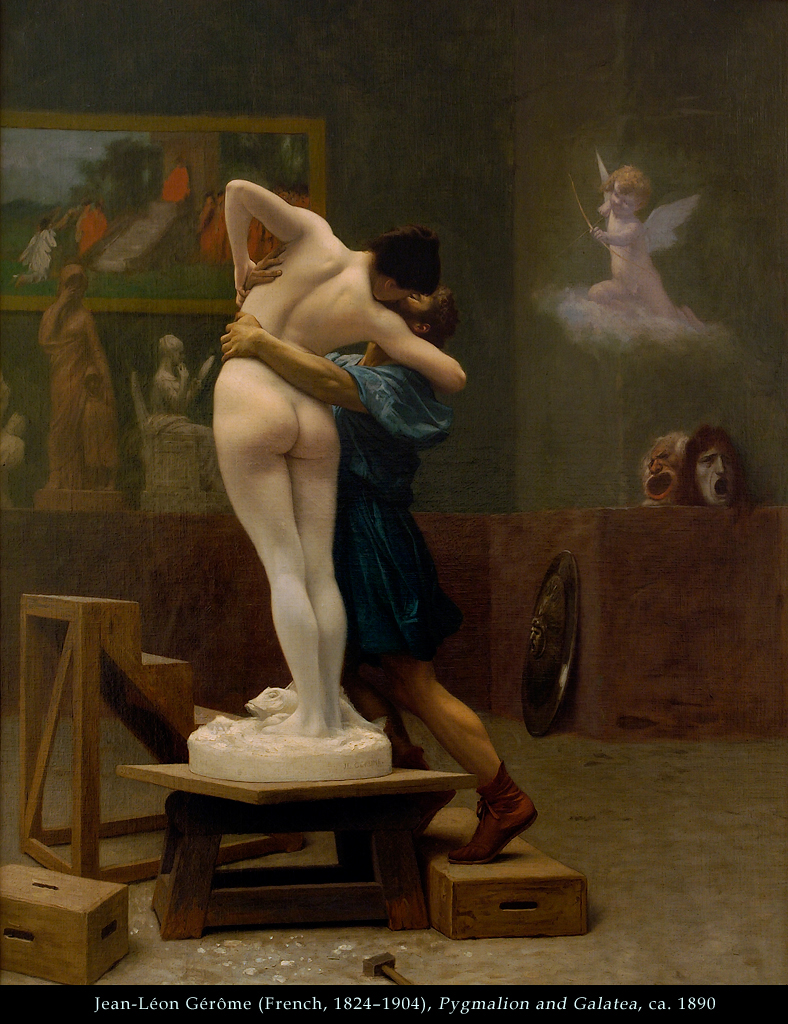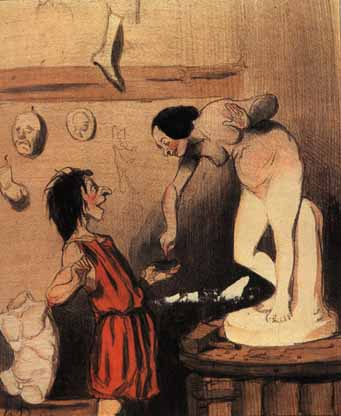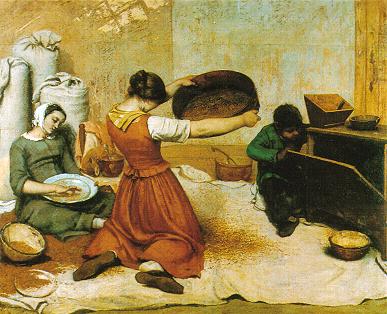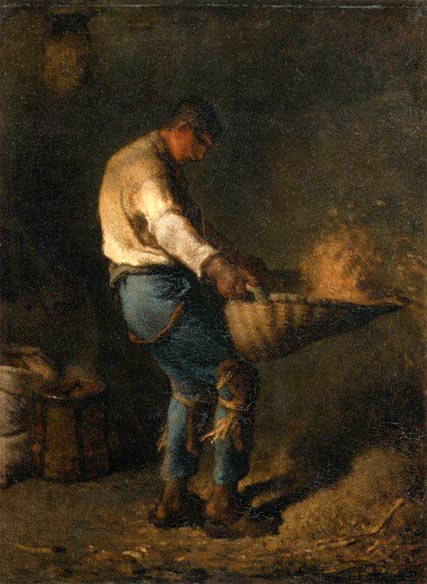Few styles fell so far into disrepute as the once-prized academic art of the nineteenth-century.Bad as most of it really was, some of it did not deserve the exile it had received. This banishment of French Salon paintings took a downward plunge from places of esteem to the limbo or mothball of basement storage. At one time, these paintings were riding high, and priced higher, while impressionism was a scandal and impressionist paintings could be purchased for the price of a good Salon frame. No tables have ever turned more completely.
“Bouguereau was a staunch traditionalist whose realistic genre paintings and mythological themes were modern interpretations of Classical subjects-both pagan and Christian-with a heavy concentration on the female human body. Although he created an idealized world, his almost photo-realistic style brought to life his goddesses, nymphs, bathers, shepherdesses, and madonnas in a way which was very appealing to rich art patrons of his time. Some critics, however, preferred the honesty of Jean-Francois Millet’s truer-to-life depiction of hard-working farmers and laborers….” read more: http://www.bouguereau.org/biography.html a

This pair of lovers caught in the act of fleeing, with drapery flying, from a sudden squall form the central images of the large painting, "The Storm" by Pierre Auguste Cot. Painted in 1880 for the French Salon trade, it has been in the Met since 1887. Although many academic paintings , once fashionable in the nineteenth-century, eventually found their home in museum basement storage, Cot's tour de force avoided that fate. ... read more: http://www.metmuseum.org/works_of_art/collection_database/european_paintings/the_storm_pierre_auguste_cot/objectview.aspx?collID=11&OID=110000430
Everybody knows Cezanne, but less so his contemporary Gerome,who fell into the void though he was so wel thought of during his lifetime that his objections to impressionism- “filth” and “a great moral slackening”- helped keep some very worthy paintings, including Cezanne’s, out of the Louvre. The same comparison could be made between Renoir, the beloved, and Bouguereau, the ex-beloved. Its more or less safe to suggest that Renoir at his most mediocre and Bourguereau at his best may have something in common, but in all probability, but that gate is not open very wide. The default attitude toward Salon painting is generally one of amused condescension; the outcast Salon painters are presented as the Bad Guys and the impressionists, whom indeed were persecuted, are the Good Guys. The defeat of the villains was comprehensive enough to satisfy even the most sadistic enemy; however the undeniable faults and possible virtues of Salon painting have been hashed together.

For the nineteenth-century public, a picture was "art" as long as it bore the solemn stamp of Salon approval. Jean Leon Gerome's pretentious version of the classic myth, Pygmalion and Galatea, an academic exercise spiced with genteel bourgeois eroticism, remained a collector's of high honor. read more: https://wiki.uco.edu/display/~nbednarz/Pygmalion+and+Galatea-Nicole+Bednarz
…In his own time, Bouguereau was considered to be one of the greatest painters in the world by the Academic art community, and simultaneously he was reviled by the avant-garde. He also gained wide fame in Belgium, Holland, Spain, and in the United States, and commanded high prices.
Bouguereau’s career was a nearly straight up ascent with hardly a setback. To many, he epitomized taste and refinement, and a respect for tradition. To others, he was a competent technician stuck in the past. Degas and his associates used the term “Bougeuereaute” in a derogatory manner to describe any artistic style reliant on “slick and artificial surfaces”. In 1900, Degas and Monet reportedly named him as most likely to be remembered as the greatest 19th-century French painter by the year 2000, according to chairman Fred Ross of the Art Renewal Center – although with Degas’ famous trenchant wit, and the aesthetic tendencies of the two Impressionists, it is possible the statement was meant as an ironic comment on the taste of the future public…. read more: http://www.bouguereau.org/biography.html a

Daumier's burlesque of Jean Leon Germoe's Pygmalion read more: http://www.flickr.com/photos/42051735@N04/4083323290/
The Salon originated as an official exhibition in which accredited painters could present their work,summarize their theories , and introduce their proteges, usually by means of large demonstration pictures. About 250,000 paintings were given official exhibition in France between 1800 and 1900 ,and just as many presented for exhibition but rejected by the juries. Most of them were bad or a best meaningless since the number of good painters is limited, even in France. The Salon was finally crushed under the weight of its own abuses. It became not only the annual testing ground for new talent and the prancing around of established talent, but also the torture chamber for any exceptional picture that happened to get in for one reason or another , as Manet’s “Olympia” did in 1865.
…Bouguereau’s works were eagerly bought by American millionaires who considered him the most important French artist of that time. But after 1920, Bouguereau fell into disrepute, due in part to changing tastes and partly to his staunch opposition to the Impressionists who were finally gaining acceptance. For decades following, his name was not even mentioned in encyclopedias.read more: http://www.bouguereau.org/biography.html a

---After Dinner at Ornans, 1848. Courbet has a love/hate relationship with the art world of Paris. While they hated him for the Realism they didn't want to see, they loved him for the Realism they could tolerate. This lifesized painting got mixed but positive reception in the Salon of 1849. It shows Courbet's family; his father sleeping in his chair, Courbet is listening to Promayet play the violin. "In their inability to feel that everyday life contains mightier and saner poetry than fabulous and historical scenes, Courbet's contemporaries no doubt drove him to emphasize his note in order to gain a better understanding."* This painting was awarded a Gold Medal, and therefore was automatically purchase
r 1500 franks.--- read more:http://www.teamliquid.net/blogs/viewblog.php?topic_id=110619The Salon juries were dominated by the pedants of the French Academy, an institution whose history in the nineteenth-century is pretty atrocious and whose practices were loathed by every other artist and intellectual of much perception, and whose chairs continued to be coveted beyond all other honors nonetheless. As one of the five branches of the Institute of France, the Academy of Fine Arts was nominally dedicated to the recognition of French genius and the fostering of the highest achievements in art. In practice, the Academy became a closed circle of conventional talents, of men skilled equally in the manipulation of trite formulas for painting and the manipulation of advantageous personal contacts.
ADDENDUM:
“However, by the mid-nineteenth century, academies across Europe were undercut by what would later be seen as avant-garde movements. Some artists sought change from within, exhibiting their radical works at these official venues. In many cases, the Academies showed a rather enlightened openness to the institutional critique offered by the Pre-Raphaelites in England, or the Realists in France represented by Gustave Courbet , Jean-François Millet, and Édouard Manet, and repeatedly accepted their works for exhibition. By the later nineteenth century, alternate exhibition venues challenged their hegemony. The Grosvenor Gallery on New Bond Street in London (1877–90) was where Edward Burne-Jones showed his majestic Aestheticist painting, The Love Song , along with eight other works in 1878. In Paris, the first of the eight Impressionist exhibitions, initially called the Société Anonyme des Artistes Peintres, Sculpteurs, Graveurs, etc., was held from April 15 to May 15, 1874, at 35 boulevard des Capucines, in the former studios of the photographer Nadar….

"The Winnowers 1853-4 This painting is perhaps the most famous painting dealing with his preoccupation with the ordinary activities of life, especially in his hometown of Ornans. That is, apart from the Stonebreakers, which was discussed in an earlier edition. In this painting, the Winnowers are doing just that; winnowing, or separating Wheat from chaff. He painted this painting in his studio in Ornans. The painting invites a narrative. That is to say, there is a suggestion of different events ocurring over time. Such as, Winnowing! and then, getting tired and taking a rest on some wheat sacks while plucking thoughtfully at some wheat in a dish. Later, some boy comes in looking for something, he checks in the wooden box, thinking it might be there. There are various bowls and containers with varying amounts of fullness, indicating that their task has a start, and will have an end. Compare this with a painting like The Milkmaid, by Jan Vermeer, in which there is no sense of narrative. There is no beginning to the milk, nor any end, there is nothing she started doing, nothing she needs to be doing after, just pouring milk for all eternity...." read more: http://www.teamliquid.net/blogs/viewblog.php?topic_id=110619
While artists in England, like Frederic Leighton and George Frederick Watts, simultaneously showed at the Royal Academy (RA) and the Grosvenor Gallery, in France the Impressionist exhibit constituted a dissenting and independent gambit—participants were not allowed to submit works to that year’s Salon (although this was not such a risk—the Salon jury had rejected most of the submissions by artists like Monet in the late 1860s). Audiences in England were, perhaps, more open to the alternate conceptions of art found at Grosvenor Gallery, and the artists of the Aesthetic movement who showed there found immediate success. By contrast, the first Impressionist exhibition attracted 3,500 visitors, as compared to the 450,000 attendees of the Salon that opened two weeks later…. But it is wrong to suggest that advanced art was absent from the RA and Salon walls. J. M. W. Turner showed consistently at the RA in the first half of the century. The Metropolitan’s The Grand Canal, Venice, and Whalers (The Whale Ship) (Tate, London) were exhibited at the 1835 and 1845 shows respectively, the former at Somerset House on the Strand, and the latter at the RA’s former home
Source: The Salon and The Royal Academy | Thematic Essay | Heilbrunn Timeline of Art History | The Metropolitan Museum of Art
Read More: http://www.metmuseum.org/toah/hd/sara/hd_sara.htm
———————————————————————
“Other artists too, among this first generation of new French Realists, such as Adolphe’s brother, Armand, their friend, Hédouin, Guillemin, Muller, Célestin Nanteuil and Jean François Millet, received Gautier’s support and invoked his enthusiasm. In particular—contrary to another popular myth, which sees Gautier as the advocate of a highly polished academic technique and the enemy of Millet—it was this critic who first delighted in Millet’s rugged brushstrokes and his humble subjects. Although Millet’s Winnower, exhibited at the 1848 Salon, was not his first image of peasant toil, a controversial subject in itself, it was the first recognized at the Salon, and in particular by Gautier….

Hoocher:Millet's early works were modeled on eighteenth-century pastorals, but during the 1840's the influence of Daumier encouraged him to paint in a more vigorous and sober style. 'His Winnower of 1848' set the seal on this new direction. The painting was exhibited at the Salon of 1848. read more: http://hoocher.com/Jean_Francois_Millet/Jean_Francois_Millet.html
…It was also Gautier who first greeted with enthusiasm the life-size interiors, depicting poor or unfortunate citizens, painted by Boissard, Lessore and Antigna. Moreover, in 1846, Duveau’s very large genre painting, The Day after a Storm, a scene of “distressing effect” with figures five foot high, inspired Gautier to applaud the idea of executing life-size works depicting everyday, contemporary subjects and events….Gustave Courbet’s first Salon success, his After Dinner at Ornans, corresponded marvellously, therefore, with Gautier’s recommendations—of which Courbet would certainly have been aware. Gautier was one of the few critics who were not hostile to this audaciously large genre painting. He sincerely praised its “banal provincial subject” executed in a “frank and masterful manner”:
This powerful and lively painting has the charm of simple things and doesn’t lack poetic feeling, as rough as it might appear to society ladies who prefer the troubadour style or Spanish dandies.
Gautier’s enthusiasm for this controversial painting did not conflict with his admiration for the work of artists such as Delacroix or Couture. For him, “excellent, real and solid painting” would always deserve praise as long as there was life, colour, genuine artistic expression and a sincerity of execution.” Read More: http://www.h-france.net/rude/rude%20volume%20ii/Stocks%20Final%20Version.pdf
Read More: http://www.teamliquid.net/blogs/viewblog.php?topic_id=110619





 COMMENTS
COMMENTS